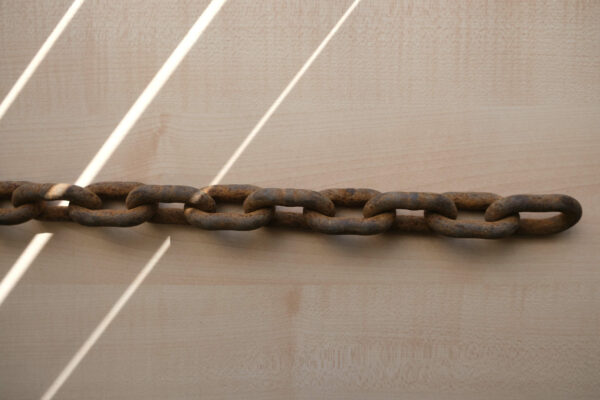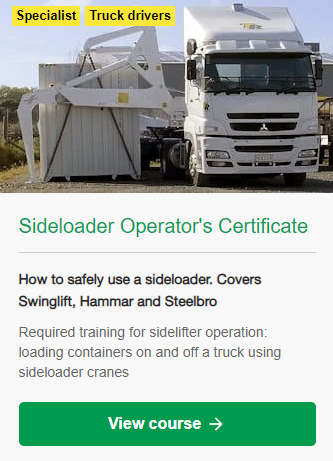Sideloaders can lift containers exceeding 30 tonnes, and whenever you’re dealing with a heavy, suspended weight, there are always hazards. It’s important to get sideloader or sidelifter training to understand how to operate the sideloader safely, and to understand the risks.
When accidents occur, they carry a lot of kinetic energy and can cause significant damage to people, equipment and cargo. These are the main forms of accidents that sideloader operators face the risk of.
Worn corner castings
Each chain ends in a lug which fits into a corner casting on a container. The corner castings on old containers get worn and the lugs can slip out. This can cause the container to drop and swing, with the following potential results:
- The forces on the sideloader tip it over.
- The force on the remaining chain(s) breaks or stretches them.
- The container swings into the vehicle and damages it
- The container swings outwards and hits someone
- Freight in the container shifts, damaging it.
On-road rollover
Driving with a high-unbalanced load dramatically increases the chance of a rollover. If you suspect you have an unbalanced load, it’s best to stop and check. However, you may still need to make progress, in which case, keep your speed low. Rollover training will help.
Container-side rollover
The vehicle can roll to the side that the container is being lifted if:
- the container is too heavy
- there is a mechanical failure or breakage
- wind gusts overload the stabilisers
- the legs sink into the ground causing the vehicle to lean
- the vehicle is leaning towards the container when parked
- the vehicle moves while loading
- the load in the container shifts while loading; or
- the operator clumsily uses the cranes.
Offside rollover
Most sideloaders only have stabiliser legs that extend on the lifting side. This forms a wide base so that lifting the container doesn’t tip the sideloader over. However, poor operation of the sideloader cranes, or strong winds, can cause the container to swing. This constantly changes the centre of gravity of the vehicle. As the container is brought across to the vehicle, if it swings to the offside (i.e. the side that doesn’t have stabiliser legs), it can go outside the stability envelope and tip the vehicle over.
When offside stabilisers are present, they should always be used.
Transfer vehicle balance
When transferring from a skeletal trailer (for example), where the stabilisers are resting on the chassis, the lifting truck can become unbalanced. This is because the skeletal’s suspension has been unloaded and therefore lifts the stabiliser towards the offside, making it more likely to roll over.
Mechanical failure
Modern sideloaders have failsafe mechanisms to stop the cranes dropping when there is an issue such as a hydraulic line bursting. However, there are plenty of old sideloaders still in operation.
If the remote control fails, the sideloader must be operated from the cranes’ emergency controls, and this puts the operator inside the exclusion zone. As the controls are often not well marked, it puts the operator at risk of moving a crane in the wrong direction.
Crush injuries
Crush injuries from swinging containers or from the cranes folding in and out are the main ways in which people are injured or killed when operating a sideloader. Sideloaders are covered in decals warning about exclusion zones and crush hazards. Stay away from those areas unless the sideloader has been disabled with the e-stop button. People have even crushed themselves to death by pushing the wrong button, or creating a feedback loop where they push a button that causes the machine to hit them which keeps the button depressed.
Chain breakage
Old chains and damaged chains are more likely to fail. Sideloader chains have a certification and this should not be left to go out-of-date. As mentioned above, if a chain fails, it can cause the container to drop and swing suddenly which increases the rollover risk. Additionally, each end of the broken chain will fly off in different directions, and this impact can be enough to kill someone.
Stretched chains are not always easy to see. Compare them against a newer set.

You have no idea how the load has been packed in the container. You’ll know what’s in it due to the supplied paperwork, but not how it is loaded. All the weight might be at one end, or set very high in the container.
Operators must check the sideloader scales (if available), and load the sideloader as balanced as possible. If the sideloader does not have built-in scales, visit a weighbridge to check you are not overloading an axle. If you don’t know what your legal maximum axle weight is, then you need to do this vehicle dimensions and mass course.
Twistlock failure
Twistlocks themselves don’t often fail, but the people using them can forget to lock or unlock them before loading a container. Not unlocking them could see a gantry crane lifting the whole truck while trying to pick the container. Failure to ensure the twist locks are done up can cause the container to fail while cornering due to the lateral forces; the container would roll over the twistocks.
Manoeuvring damage
When travelling empty, container cranes should be in the 20-foot position. This is for two reasons:
When the cranes are at either end of the trainer, the balance is not as good as when they are closer together
Container cranes at the rear and front of the trailer contribute to the swept path of the whole machine. Rather than just have the deck height be the thing that the driver has to watch, they would have to watch the profile of the cranes while turning through tight corners.


